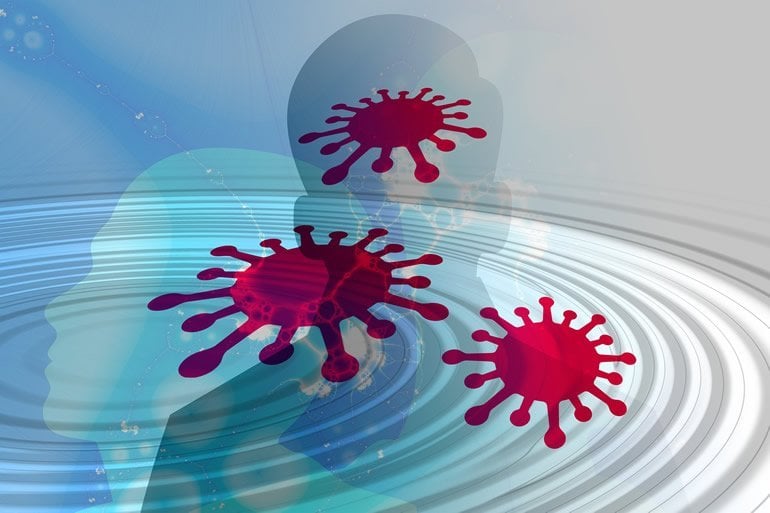Summary: The source of coronavirus public health messaging plays a role in how effective it is. When the president’s name was associated with the message, the effectiveness of the message decreased, not just compared to other sources, but even when there was no source at all.
Source: University of Connecticut
The COVID-19 pandemic has dominated the news cycle for the better part of 2020. As guidelines are continually updated to reflect changes in our understanding of how the virus spreads, it is critical people receive accurate, credible information that encourages prevention. Understanding the factors that influence these messages’ effectiveness is crucial.
A group of researchers published a paper in the American Journal of Preventive Medicine reporting their findings from a study funded by the Institute for Collaboration on Health, Intervention and Policy (InCHIP) at the University of Connecticut on how the source of a COVID-19 prevention message affects its perceived effectiveness.
This multi-institution project brought together the varied expertise of UConn Health’s Howard Tennen, a professor of public health sciences in the School of Medicine, Marcella Boynton ’05 (MA) ’09 (PhD), an assistant professor at the University of North Carolina at Chapel Hill, Joseph Lee, an associate professor from East Carolina University, and Ross O’Hara, a former UConn Health postdoctoral fellow and independent researcher from Michigan.
The team conducted an experiment with a diverse group of nearly 1,000 American adults to test the effectiveness of different messages encouraging coronavirus safety measures such as wearing a mask or social distancing. Messages systematically varied in several ways, including who was attributed as the source of the message. Participants were told messages came from President Donald Trump, the Centers for Disease Control and Prevention (CDC), Trump and the CDC, a local or state health agency, or no source.
The team found when Trump’s name was associated with the message, the effectiveness of those messages decreased, not just compared to other sources, but even when there was no source at all.
“Asking the public to restrict their behavior and social ties in such a big way is a difficult sell,” Tennen says. “For these prevention messages to be believed, they have to come from a trusted source. We are in uncharted waters when it comes to effectively persuading people to wear masks and socially distance, and that’s why we thought conducting this study was so important.”
After receiving a postcard encouraging citizens to engage in social distancing and other prevention behaviors with Trump’s name prominently featured, Boynton wondered whether this unusual messaging strategy was more effective compared to the traditional approach of citing a public health agency or organization as the message source.

Interestingly, the researchers found even participants who said they trust Trump did not find messages from him more effective compared to other message sources. However, those who said they do not trust the president found the messages significantly less effective when associated with Trump.
“Linking President Trump to prevention messages seems to work to the detriment of what those messages were trying to do,” Boynton, who remains affiliated with InCHIP, says.
Boynton has a background in health behavior research and, with funding from the National Cancer Institute and Food and Drug Administration, had previously studied how to effectively communicate the health risks of tobacco use. She thought the current public health crisis called for the same kind of research methods to identify the best way to get credible, evidence-based prevention messages to the public.
These findings are important as various agencies and news outlets are trying to determine the best strategies to ensure these health messages are as effective as possible.
“A lot of the current prevention messaging efforts are just people’s best guesses at what might work,” Boynton says.
The team hopes to complete a follow up study examining how these types of messages affect people’s engagement in prevention behaviors such as wearing a mask.
“I think behavioral science has a lot to contribute to stopping COVID-19, but so far, its potential has been underrealized and underutilized,” Boynton says. “Until we have better treatments or a vaccine, a big part of stopping the spread of this disease is going to be about changing behavior.”
About this coronavirus research article
Source:
University of Connecticut
Contacts:
Jessica McBride – University of Connecticut
Image Source:
The image is in the public domain.
Original Research: Open access
“The Impact of Public Health Organization and Political Figure Message Sources on Reactions to Coronavirus Prevention Message” by Marcella H. Boynton, PhD, Ross E. O’Hara, PhD, Howard Tennen, PhD, Joseph G.L. Lee, PhD, MPH. American Journal of Preventive Medicine.
Abstract
The Impact of Public Health Organization and Political Figure Message Sources on Reactions to Coronavirus Prevention Message
Severe acute respiratory syndrome coronavirus 2 (SARS-CoV-2) has emerged as a global health emergency. Currently, there are no effective vaccines and limited biomedical treatment options. Multiple countries, including the U.S., have not implemented effective testing, tracing, or isolation and quarantine efforts. Consequently, behaviors such as using face coverings are crucial to averting substantial morbidity and mortality. Government officials, the Centers for Disease Control and Prevention (CDC), and health departments across the U.S. have used a variety of messaging approaches to promote these behaviors. One early effort, “President Trump’s Coronavirus Guidelines for America,” included a postcard mailed to every U.S. household at a cost to the U.S. Postal Service of $28 million.1 Each card was branded in large text with President Trump’s name and with small White House and CDC logos. As part of a larger study to identify effective coronavirus prevention message elements, the authors experimentally assessed the effect of message source on perceived message effectiveness (PME) and reactance (an oppositional reaction to a message).






